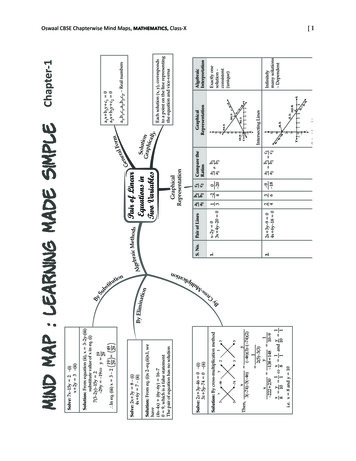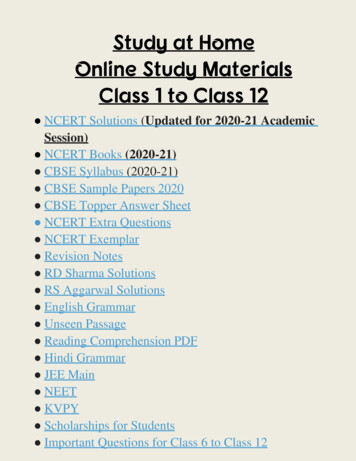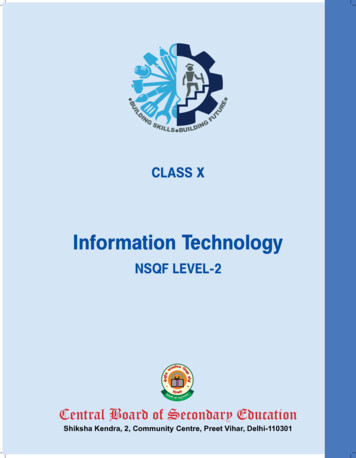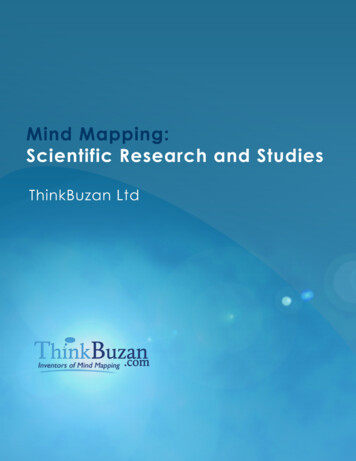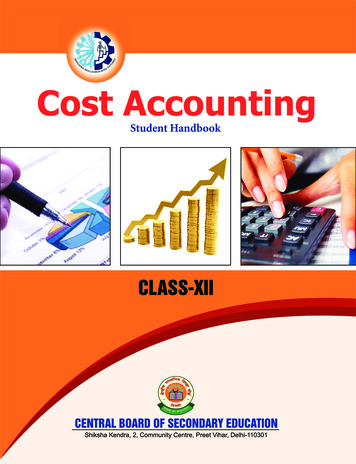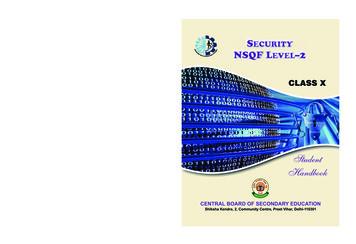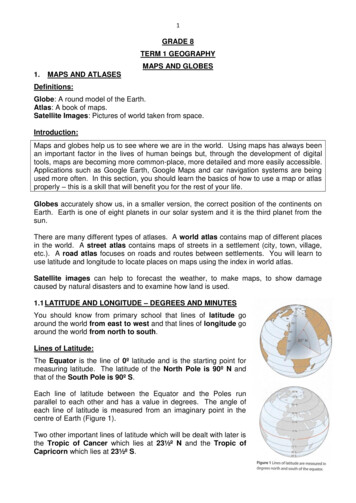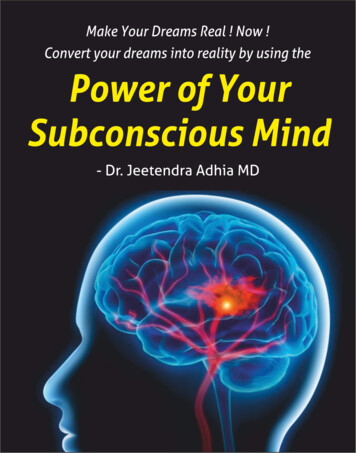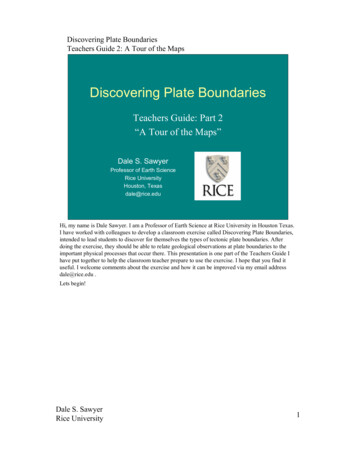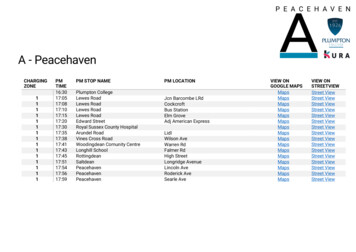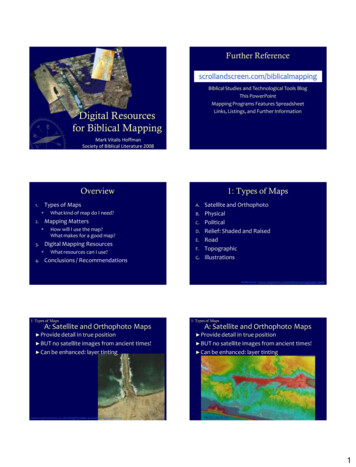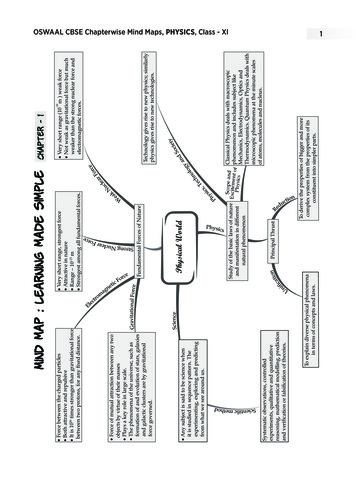
Transcription
-16Technology gives rise to new physics; similarlyphysics gives rise to new technologies. Very short range (10 m ) weak force Not weak as gravitational force but muchweaker than the strong nuclear force andelectromagnetic forces.Chapter - 1Principal ThrustTo derive the properties of bigger and morecomplex system from the properties of itsconstituent into simpler parts.ScopClassical Physics deals with macroscopicStudy of the basic laws of nature Excitemeeandnt of phenomenon and includes subject likePhysicsand manifestation in differentMechanics, Electrodynamics, Optics andnatural phenomenonThermodynamics. Quantum Physics deals withmicroscopic phenomena at the minute scalesof atoms, molecules and nucleus.Physical WorldFundamental Forces of Nature Very short range, strongest force Attractive in nature Range – 10-15 m Strongest among all fundamental forces.To explain diverse physical phenomenain terms of concepts and laws.Systematic observations, controlledexperiments, qualitative and quantitativereasoning, mathematical modelling, predictionand verification or falsification of theories. Any subject is said to be science whenit is studied in sequence pattern. Theexperimenting, exploring and predictingfrom what we see around us. Force of mutual attraction between any twoobjects by virtue of their masses Plays a key role in large scale. The phenomena of the universe, such asformation of and evolution of stars, galaxiesand galactic clusters are by gravitationalforce governed. Force between the charged particles Both attractive and repulsive It is 1036 times stronger than gravitational forcebetween two protons, for any fixed distance.Mind map : learning made simpleOSWAAL CBSE Chapterwise Mind Maps, PHYSICS, Class - XI1
mean 1( aδa a mean 100ameann a2 . anPercentage Errror amean a meanameanna1 a2 . anRelative Errrora an an – ameanAbsolute Errror)Types Z A BAll non-zero digitsAll zero between two non-zero digitsIf the number is less than 1, the zero(s)on the right of decimal point but to theleft of the non-digit zero are not significant.Terminal or trailing zero (s) in a numberwithout a decimal point arenot significante.g In 020342.010Here 20342.01 are significantComparison with a certaininternationally accepted referencestandard is called unitReference standard use tomeasure physical quantities.MeasurementUnits andMeasurements Z A B Z A B ivedZ A B / Cqr Z A B C p q r Z A B C IfpUniversal acceptanceNon-perishableWell definedDoes not change with timeQuantities plane angle andsolid angle have radian andsteradian as units(Internationally accepted)S.I - System InternationalMKS– Metre, Kilogram, SecondFPS – Foot, Pound, SecondCGS – Centimeter, Gram, SecondSet of fundamental and derived units The units which are derived fromfundamental units are calledtsderived units.Physicalquantities like speed acceleration have derived unitslike m/s, m/s2uniMass, length, time, temperature,electric current, luminous intensityand amount of substance have fundamentalunits. Kilogram, metre, second, Kelvin,ampere, candela and mol respectively.Closeness of the measuredvalue to the true valueityntauerwpoIf Z A/BDertsniChapter - 2PropertiesLimit of resolution ofquantity measured.TypesMearaised suredtoqtheCombination of ErrorsinError True Value – Measured Value Expression which shows how and which of thebase quantities represent the dimensions of aphysical quantity is called dimension formula.e.g:- Force MLT –2 Mind map : learning made r Division2OSWAAL CBSE Chapterwise Mind Maps, PHYSICS, Class - XI
x v0t at(ii)In opposite direction, it will be DifferenceIn same direction, it will be Sumvavg Rate of change of positionof an object w.r.t time ingiven direction .Vector QuantityAverage x tTotal displacement Total time takenityoclVe(ii) vAB vAn vB vBnA vBB vAa ( 2n-1)2TypesMotion in aStraight LinetRate of changeof velocity, a vChapter - 3orm xvinst lim t 0 t dxdt AveThe shotest distancetraversed by anyobject in calleddisplacement It in a vector quantity. Total length of the path traversedby any object is called its distance It is scalar quantity. When the magnitude or the directionof velocity changes w.r.t. time.Equal distances are traversed inequal amount of time.v 1t 1 v2 t2 . vn tnt 1 t 2 . t nWhen object traversed differentspeeds in different time ofintervals.s1 s2 s3s . nv1 v2 v3vnWhen object traversed differentdistances with different speeds.Distance traversed/time taken .Scalar quantitymentDisplaceetancDisno ti o nti oMoNon - uni form mifUn edpeeSgra(i)(iv) xnth v0 22(iii) v v0 2axv v at0(i)FreeFallns ofquatiotic ean motionnem cceleratioKiaylrmi founEarth’s gravity (g 9.8m/s2).On neglecting air resistance, it is acase of motion with uniformacceleration. e.g Apple fallingfrom a tree.An object falling because ofTotal time interval v tTotal change in velocityAccel erationaavg Ve locity vdva inst lim t 0 tdtMind map : learning made simpleOSWAAL CBSE Chapterwise Mind Maps, PHYSICS, Class - XI3
2Horizontal range,R u sin2θgTotal time of flight,Tf 2u sinθgMaximum height,Hmax u2sin2θ2gVectors havingcommon startingpoint.If, A – BVectors havingsame magnitudebut opposite directioneg. A is a negative of BVectors havingsame directionand magnitudegnituIt has magnitude asone or unityA A Ay x tanθ–EquPlanetilejecnotioPrmoMotioninaMotionin a Planex (ucosθ)t;y (u sinθ) t - 1 gt22Motion of an object thatis in flight after being thrownor projected.rVecto Ptileation of path of projecgx22u2cos2 PLaw of ParallelogramLaw of Triangle R P Q RRQQAddition ofVectorsat any instantpoax 0,ay g C o m V& AB VBA VAB –VBA V BA VB –VA V AB VA –VBac v2/r rw2 4π2 rv2A body in a circular motion actedupon by an acceleration directedtowards centre of the circularmotion.Angular velocity ,ω θ/tAngular acceleration,d ω/ teg- merry go around.When an object follows a circular path ata constant speed , the motion of theobject is called uniform circular motion. a axi ayj; ax dvx/dt & ay dvy/dt a ax2 ay2 v vx i vy j , magnitude v vx2 vy2 i y jPosition vector , r x Displacement vector , r x ji y λ A λAu ucosθ,u u sinθxyMotion of Body under2 dimensional frame. A–B A (–B)Chapter - 4neIt has zero magnitudeand orbitary directionMind map : learning made simpleele r a ti o nf accCentripetaln tso4OSWAAL CBSE Chapterwise Mind Maps, PHYSICS, Class - XIAcceleration
nioctmvROpposes impendingrelative motionFS µsRCentrnctioFriip e t a l f o r c eForce which opposesthe relative motionof a bodyCentrifugal force isequal and oppositeto centripetal force.F 2on estKinetic Friction,e g carA push or pull whichchanges or tends tochange state of restor of uniformmotion of a body.Oppose actualrolling motionµ R µk µstionfricgllinRoOppose actual relativemotionFk µkReLaws of MotionTypesInrtiaof mwo tionhc o e n m o vingmes i n r e stA particle is said tobe in equilibriumwhen net externalforce on theparticle is zero. F1 F2 . Fn 0Momentton’s law ofNewtionof moResistance tochange its state ofrest or motion.NeProduct of mass andvelocity of the bodyp mvII l a wmAuB mBuB mAvA mBvBThe total momentum of anisolated system of interactingparticles is conserveddtImpulse force timeI change in momentumI mv muI m vTotal change in momentumTo every action there is alwaysanequal& opposite reaction.FAB FBAAction & reaction act on twodifferent bodieswhere ‘a’ accelerationThe rate of change of momentumof a body is directly proportionalto the applied force and takes placein the direction in which the forcedpacts. F F maoti o no n’sof mwtlaw’sonrtiaIneEvery body continuesto be in its state of rest oruniform motion unlessacted upon by a non-zeron external force.oitMoAlso called law of Inertia.ofChapter - 5lsepuImMaximum value of static frictionncaronForce which makes a bodymove along a circular pathwith a uniform speed.a car on banked roadMotionofaWhen friction force istaken into consideration½ µ tan θ v max Rg s 1 µ s tan θ When no friction force isconsideredv max Rg tan θofonotiMVmax µS Rgadroaelvle)(PLimitingfrictiostFo r c eniootmofStaticfrireumof conservationLawofmomentumrr in ieg, when a c a m otco m e s i nofIn e rti aawII l’s InotNewarticleof a piumibruilEqNewtMind map : learning made simpleOSWAAL CBSE Chapterwise Mind Maps, PHYSICS, Class - XI5
When force and displacementare perpendicular toeach other. W zerowhen θ π2When force (F) and displacement (S)are in opposite direction.W will be (-ve) when π 0 π2When force (F) and displacement (S)are in same direction. πW will be ve when 0 θ 2An instance of onemoving body strikingagainst anotherTypesZoerrkwosType Total energy and linearmomentum conserved. Kinetic energy not conserved.( )Time ( t )Work wPower (P)Work, Energy andPower1hp 746watt1kWH 3.6 106J ds Pinst . F F vdtP s211 W s Fdscosθ s F dss2Work done by a variable force W Fscos θ F sWork is said to bedone when force producesdisplacement.Work done by constantforceyrgTypes of mechanical energyCapacity of doingworkVarious forms11mv 2 – mu2 W22Change in Kinetic Energy Work done by net force onthe body i.e;By virtue of positionEp mghk spring constant P ote n1U kx 221p2E K mv 2 22mBy virtue of velocityNuclear EnergyElectrical EnergyChemical EnergyHeat EnergyEnergy can neither be created nordestroyed; it can only betransformed from one form toanother.Equivalence of mass and EnergyE mc2FormulaRate of doing workKineticEnergy Total mechanical/kineticenergy is conserved. Momentum is conserved.EneChapter - 6ti alEnerMind map : learning made simpleri n gf Sp(W)Workgyo6OSWAAL CBSE Chapterwise Mind Maps, PHYSICS, Class - XI
momentofforceVcm ni ii 1mini 1I mi ri 2Inertia of rotationalmotion, M.I.,Systems of Particles andRotational MotionVcm ni 1i mi 1n m vi iThe point where the wholemass of the system issupposed to be concentratedeodyRigid btionus of gyraRadiaxi 1nacm Accelerationmassof th of ceesysteimi ai mass for rigid bodiestre of mCenelbodypedahrsulaof pregTheoremesomofaitterf inotenomMllaraI I cm mr 2Icm M.I.about the parallelaxis through the centreof massis independent of the statei.e., rest or motion of the body.A body with perfectly definiteand unchanging shape.nr12 r2 2 . rn 2IK mK mI 2122I one edge mI3(2) Ring I cm mR22Idiameter mR22(3) Disc I cm mR22Idiameter mR4(4) Solid sphereIdiameter 2 mR25(1) Rod I cm Chapter - 7ofretnm i 1n m rmasse ofrtcentemofnsysoeiitthofAngular momentumTorque or couple orPosition of centre of massof an object changes intranslatory motionbut remains unchangedin rotatory motion.Position of centre of massdepends upon shape,size, distribution of massof the body.L Ιω mvr r mvL r p rpsinθ τ r F r Fsinθ n τrotational Ιαperpendicular axes x, yand z respectivelyTheoEqurematioof pnsoferpeaxndicularroesTheorems of momenttatioof InertianaPosMomentInertiae ofCentrmassionotlmVelocity ofCenter massof the systemsIz Ix I yI x , I y & I z moments of inertia aboutMind map : learning made simpleOSWAAL CBSE Chapterwise Mind Maps, PHYSICS, Class - XI7
2mL23 ConstantGmr2 Gmwork done massrU r GMm· Gravitational Potential EnergyVg · Gravitational potentialI · Gravitational field Intensity(iii) Law of Periods: T awhere, a length ofsemi-major axisdt F Gm1 m2, G 6.67 10 11 Nm2 kg 2r2(i)(ii)(iii)(iv)elness(g)vorb gR 2 gR(iii) with rotation of earth about its own axisg’ g– Rω 2 cos 2 λ ,0At poles, λ 90 , g maximum0At equator, λ 0 , g minimumi.e. g decreases with depthg′ g 1 d , RE 2h g ′ g 1 , RE i.e. g decreases with heightR2eG Mewith heightg Acceleration possessed by anobject during free falldue to earth’s gravitational pull,During free fall under gravityinside a spacecraft or satellitea body is weightless i.e., effectiveweight becomes zero.2ve2 GM / R1 Mm GMm GMm – G2r r 2rE K.E P.ETotal Energy of a satelliteOrbitals speed(ii) with depth(i)gravityWeakest force in Nature.Central as well as conservative.Always attractive in nature.Applicable for all bodies irrespectiveof their shape, size and position.forc eAcceleration due toCharacteristicsofgravitationalw ofNe a wltoGravitationWhen two mass bodies are separted by a distance,they experience an attractive forcewhich is directly proportional to the product oftheir masses and inversaly proportional to thesquare of their separation.lnatioattialtenodpandlFiemotionw- of planetaryer ’s LaKeplSatlitHeavenly object that revolvesaround a planet v esc Earth ’s v esc 11.2km/sEscape speedChapter - 8ssdA(i) Law of Orbit: Everyplanet revolves aroundthe Sun in an ellipticalorbit and Sun is at itsone focus.(ii) Law of Area: The radiusvector drawn from theSun to a planet sweepsout equal areas in equalintervals of time.Geostationary satellitePolarsatelliteHeight from earth’s surface 880kmTime period 84minOrbital velocity 7.92km/seHeight from surface of earth 36000kmRadius of orbit 42,400kmTime periods 24 hoursOrbital velocity 3.1km/sMind map : learning made simpletl eGraviWheign’G s unra ivit a v e r s atio ln8OSWAAL CBSE Chapterwise Mind Maps, PHYSICS, Class - XI
Deforming force applied normal Fn AAreaForce Changing Volume FV AAreapelongitudinal stress F / A longitudinal strain l / lF l Mg l π r 2lAlY Y Young’s modulus of elasticityProperty of material byvirtue of which it regains itoriginal shape & size after theremoval of deforming forceStress9 1 39 Bη or Y Y B ηη 3B(iv)Es ModulusYoung’Restoring force per unit areai.e., stress AFs(iii) Shearing area or tangential stressTangential ForceF tAArea (ii) Volumetric stress (i) Longitudinal stressσ (iii)3B 2 η2η 6BRelation between Y, B, η & σ(i)Y 3B (1 2 σ)Y 2η (1 σ)(ii)Mechanical Propertiesof SolidsElasticityElastic potential energy in a stretched1wire stress strain volume of the wire2Ty P 1B ; compressibility V BVhydraulic stressB volume strainBulk modulus or volume modulus of elasticityBulk ModulusTypes of Modulus of ElasticityWithin the elastic limit, stress isdirectly proportional to strain.i.e., stress strainHooke’slawVchange in length l original lengthlooin volume V ε changeoriginal volumeV Shearing strain angular displacement of theplane perpendicular to the fixed surface θVolumetric strainLongitudinal strainTη η σsFF A εs θAθtangential stressshearing strainRigidity or shear modulus of elasticityRatio of change inconfiguration to originalconfigurationchange in configurationStrain original configurationModulus of RigidityStrain(iii)(ii)(i)Laternal strain (β) d / d Longitudinal strain (α ) l / lValue of σ lies between 0 and 0.5Poision’s ratio(σ) Chapter - 9esrgyneeltiatenocPstilaypMind map : learning made simpleOSWAAL CBSE Chapterwise Mind Maps, PHYSICS, Class - XI9
21222hρm gρ (a 2 – a 2)of continuitym a1v1ρ1 a2v2ρ2for an incompressible liquid,ρ1 ρ2 then a1v1 a2v2or av constant Pascal’s law : The pressure exertedat any point on an enclosed liquid istransmitted equally in all direction.Hydraulic brakes and hydraulic liftsare based on Pacal’s law. EquationFlVenturimeterApplicationsowoffl u( ) E A That can flow like liquids and gasesMechanical Propertiesof fluidsForm uViP)soluste P resure(Total or actual pressure at a point.Absolute pressure atmospheric pressure gauge pressureGalaeit yDifference between the absolute pressure at a pointand the atmospheric pressure.Pg absolute pressure(P) – atmospheric pressure(Pa)density of substancedensity of water at 4oCDensity of water at 4 C i.e.,maximum density of water 1.0 103 kg/m3Volume(v)Density(ρ) Mass(m)Ftension S lwork done in increasing area W Surface Energy increase in surfacearea A2Scosθ Capillary rise or fall, h r ρg Excess Pressure inside a drop (liquid)2SPexcess R Excess Pressure inside a bubble (soap)4SPexcess RStroke’s law F 6 ηvrOpposing force between different layers offluid in relative motionViscous drag F ηA dvdxη coefficient of viscosityLift of an aircraft wing.Sprayer or atomizerBlowing off the roofs during windstorm. SurfaceoooChapter - 10Relative Density or specific gravity )(PgresusreePguPressure (atm) exerted by the atmosphere.At sea level, 1 atm pressure exerted by 0.76mof Hg hρg 0.76 13.6 103 9.8 1.013 105 Nm-2 101.3kPaPa)re(usesPricrhePressure(P) thrust(F) limA 0dFarea(A)dAPressure exerted by a liquid column of height h, (p) hρgidsss coFor an incompressible non-viscous streamline,irrotational flow of fluid,1P ρ v 2 ρ gh constant2uidsof FlswLa12Streamline : In liquid flowwhenthe Velocityis less than critical velocity, each particle of theliquid passing through a point travels alongthe same path and same velocity as thepreceding particles.Turbulent : When velocity of liquid flow isgreater than critical velocity and particlesfollow zig-zag path.Q a 1a2Velocity of efflux of liquid through an orificeV 2 ghTo ric ell’sDevice used to measure the rate of flow of liquid.Volume of liquid flowing per secondMind map : learning made simpleLawAbAtmospBernoulli’sprinciple10OSWAAL CBSE Chapterwise Mind Maps, PHYSICS, Class - XI
1or λ m b44)Stefan’sBoltzmann lawWiendisplacement lawKrichofTemperatureα L – l0 l l0 Τl0(T – T0)anl coThermal Propertiesof MatterT h er mngolicofolawn’sotNewTypes (In solids)Increase in dimensions dueto increase in temperaturedPrincipleofA – A0 AdAβ A T A dT A0(T–T0)Increase in area of a solid on heating.Coefficient of superficial expansionora:b:γ 1:2:3γ 2β 3aSpecific Heat T Qcalorimetrys Q n n TV0 TdVV0 dTγ V V – V0V0(T – T0)Increase in volume of a solid on heating.Coefficient of cubical expansion. F l Y , Y Young’s modulusA l Heat lost Heat GainMolar specific heat capacity, c Heat capacity s sQSpecific heat capacity C m m TA form of energy, transferred betweentwo systems by virtue of temperaturedifference.t5For water, latent heat of fusion, L f 3.33 10 J / kg5Latent heat of vapourisation, Lv 22.6 10 J / kgCubicalor volume expanRelatsioionnteaHChapter - 11Heat required to change the state of unit mass substancewithout changing its temperature , L QmQ. x(K) A( T2 T1 ) tFor small temperature difference betweena body and its surroundings, the loss ofdQheat is given by k ( T2 T1 )dtIncrease of length of a solid on heating.Coefficient of linear expansionTC 0T 32TK 273.15–0 F – R100 0 212 32 373.15 273.15 80 – 0Relation among different temperature scalesDegree of hotness or coldness of a bodymeasuring device Thermometer(i) Conduction : heat transfer through molecular collisionswithout any actual motion of matter.(ii) Convection : heat transfer by actual motion of matterwithin the medium. Land breeze, sea breeze, tradewinds based on natural convection are some examples.(iii) Radiation : method of heat transfer requiringno material medium.E σ T T0(For a perfectly black bodyσ 5.672 Js 1 m 2 k 4E T 4 ; E σ T 4TT 3b(wine’s constant) 2.9 10 mKλmlawThermExpan alsioneλaλ Eλ constantalermTh awsLSuperficialor areaExpansionit ytivucf ’sLatentHeaAt any given temperatureMind map : learning made simpleOSWAAL CBSE Chapterwise Mind Maps, PHYSICS, Class - XI11
Two systems are in thermalequilibrium with each otherif they have the sametemperature.Heat EngineV1 V2nRTdvVWQTEfficiency η 1– 2 1– 2QT1QT1Converts continuously heat intomechanical energy in cyclic process.W PγTn- γ Constant;PV Constantγ 1TV Constantγ γCvCpRefrigerator and heat pumpV1 V2 T1 T2 ConstantP1 P2 T1 T2VCP γCVMayer’s EquationCP C Rv Vβ WQ2 Q1 - Q 2Q22T1 - TT2Refrigerator is a heat engine working in thereverse direction. Coefficient of performance,The pressure (P) & temperature (T) of theenvironment can differ from those of thesystem only infinitesimally.In this process, systemreturns to initial statefor a cyclic process U 0 (zero)Pressure ConstantTIsochoricProcessVolume ConstantP ConstantT Infinity slow process such that systems remainin thermal & mechanical equilibrium withthe surroundings throughout.processi-staticQuasCyclic ProcesscessProciarobA thermally insulatedsystem neither gainsnor loses heatIsBranch of Science which deals with concepts ofheat & temperature and their interconversion bythermodynamic processThermodynamicscapacity Relationific heatSpecPropertyTemperature ConstantPV Constant n RTEfficiency of Carnot’s engineQTη 1 – 2 1 – 2Q1T2An Ideal engine works on a reversiblecycle of four operations in succession.(i) isothermal expansion ,(ii) adiabatic expansion,(iii) isothermal compression,(iv)adiabatic compression.It is the statement of law of conservation ofIt is impossible for an engine working betweenEnergy; Q U W U P U (Here, U P U) a cyclic process to extract heat from a reservoirand convert completely into work.Chapter - 12If two systems A&B are in thermal equilibriumicswith a third system C, then A&B are in thermalamnequilibrium with each other.wyodt la yrmZerirsedFhoothMeasure of molecular disorder of a system.ftTheLawrmwoδQofrmothe econd laChange in entropy δ S dynaSmicsLawsTThermodynamicstate variablen ofamics(i) Extensive – indicate the size of thesystem. e.g. U, volume, total mass.(ii) Intensive – do not indicate size of thesystem. e.g. , pressure & temperatureot’ EngineCarnersible & IrreversiblReve ProceAny process made to proceed in thessreverse direction by changing itsconditions is called ReversibleProcess.Any process which cannotbe retraced in the reverse directionexactly is called Irreversible Process.quilibriumrmal ETheMind map : learning made simplepy (S)EntroIsothermalProcessAdiabaticProcess12OSWAAL CBSE Chapterwise Mind Maps, PHYSICS, Class - XI
3PV3P3 RT ρMMCvCp53 γ (4 f)(3 f )De greEnergy associated with each degree of freedom per molecule 1kT2Pathd omFreefre eMeane of(f)and Ki ne ti c EneyergEnHence, f is the degree of freedomfor polyatomic gases,for diatomic γ 7 γ Cv5CpCvTheory of GasesCpbrtedλ )2πnd 21ssure (Prgy (E)Re l ati on be twee n Presxeeeursy ga 32PV1 2P ρV rms3Total pressure of a mixtureof non - reacting gases,P P1 P2 . Pn2 π d2 PkBTFor polyatomic gas:(i)at room temperature, f 6(ii)at high temperature, f 8For monoatomic gas: f 3For diatomic gas :(i) at room temperature, f 5(ii) at high temperature, f 7E eDal ton’s Law of Parti al Pre ssur1VChapter - 13(If T constant)PV constantor P1V1 P2V2P esPrionrtitaipqufor monoatomicKinetic TheoryAssumption of Kinetic All the molecules of a gas are identical. The molecules of different gases are different. The molecules of gases are in a state of randommotion. The collisions of gases molecules are ecific Heat Capacityfor an ideal gas, Cp– Cv Rvmp areSpbl eob arpts qusMoRootme anwLa2 RT 2 0.816 vrms 3 vrmsM va v 8 RT 8 vrms 0.92 v rmsπ M 3π v v2 v3 . vNva v 1NrmsvwLae’slyBoAn ideal gas satisfies equation PV nRT atall pressure and temperature n no. ofmoles, R NAkB universal gas constantBehaviourUnder the same condition of temperatureand pressure equal volumes of all gasescontain equal no. of molecules.i.e. N1 N2GuyLussac’sLawV T (If P constant)V constantTV1 V 2or T1T2Charles’sLawof GasesP T (If V constant)P constantT P Por 1 2T1T2Mind map : learning made simpleOSWAAL CBSE Chapterwise Mind Maps, PHYSICS, Class - XI13
FrequencyF spring constantxDamping force Fd –bv, b damping constant-(b/2m)tx xmeAmplitude decreases with time asx xme-bt/2m sin(ωt φ)mlaceDispegsprinto aeuns datiollicOsnsioatnSHOscillations22Fo2 2d2 2d{m (ω ω ) ω b } votanφ ωd xoAmplitude, A Displacement, x (t) Acos (ωd φ)12Every oscillatory motion is periodic,but every periodic motion need not beoscillatory.To and fro motion repeatedly abouta fixed point in a definite interval of time.Driving force, F (t) Fo cosωd t OscillationsintEVelocity in SHMA Amplitude i.e.,maximum displacement of particles.dDisplacement of damped oscillatorPhaseSimple Harmonic Motion isThe smallest interval of time T)im ethe simplest form ofp eri o d ( Tafter which the motionoscillatory motionis repeatedTime varyingquantity ( ωt φ )ceOscillation of a body whose amplitude goes on decreasing with time.Here, k mkIl 2 πmglgTime period T 2 πTime period T 2 πThe number of oscillationsper secondi.e.,1ωf T 2π x(t) A(cosωt φ)Chapter - 14(a)MPhase constant or Phase angle (φ)It depends upon velocity ( v) anddisplacement of particle at t 0Mind map : learning made simpleFo rDampeda dv ω 2A cos (ωt φ)dta max ω 2 Adx – ωA sin(ωt φ )d (t )vmax ωAv When frequency of external forceis equal to natural frequencyof oscillator. ω kmF k ( x) , k mω2Force law equation for SHM1kA2 cos 2 ( ωt φ) sin2 ( ωt φ) 2Potential Energy1P.E mω 2 A2 cos2 (ωt φ)2Total energy, T.E. K.E. P.E.Kinetic Energy1K.E mω2A2 sin2 (ωt ϕ)2HMin SyrgneOscillSHM14OSWAAL CBSE Chapterwise Mind Maps, PHYSICS, Class - XI
2lmv2latio n(iii) In open organ pipe, higher harmonics, bothodd & even. In closed organ pipe, higher harmonics, oddonly.4l(b) Closed at one end ν vFundamental freq. or I harmonic ν (ii) In organ pipe:(a) Open at both ends,(i) In string: Fundamental Frequency, ν 1 TStationary wavesWaves associated with particleslike-electrons, protons, neutrons,atoms, molecules etc.tterMapoWhen two or more waves arePrinciple of superpropagating with differentsdisplacements then the neto f w a vedisplacement of collective waveis given as Y y1 y2 y3 . ynvesWaonsitiar y Waves1FrequencyWave number, v TypesDo not require any materialmedium for their propagatione.g., light wavesMechanical WavesWaves1λ)V ersin ait u dLongswavel Individual particles ofthe medium oscillatealong the direction ofpropagation of wave.Individual particles of themedium oscillate perpendicularto the direction of propagationof waveT tension & M mass/length Speed of a longitudinal wave speed of sound, V BρYPγP for air, γ 7/5ρ ρ ρRequire material mediumfor their propagationvnsTra mT ,Speed of transverse wave in a stretched stringDifference in frequencies of twosuperposing waves, νbeat ν1 ν2(( t)) A sin (–kx t) ωφy (x,y (x,t) Asin 2 π t – xT λ( ) amplitudeVelocityv0 Aω2Acceleration Amplitude a0 Aω2Essential propertiesfor propagation Elasticity Inertia Minimum frictionlare etivenm ressceaglotsspprDiBeawavelength1 1 νAngular Frequency (ω) 2 πνv νλTime period (T) tnio lengtal eRe wavν νs νm n1 n ν ν0 νm Here, v speed ofsound,v0 observer speedvs source speedvm medium speedGeneral Formula,Apparent FrequencyElectromagnetic Wavesela ntiow n inavapePropertiesb/wh wa(λ ve)& v elofrec it yque n c ( v),y (ν)Chapter - 14(b)eStespoavDoctfeEfrlewMind map : learning made simpleOSWAAL CBSE Chapterwise Mind Maps, PHYSICS, Class - XI15
sin ( δmin A ) / 2Ray OpticsMP –fo& L fo fefeWhen image is at Df f MP o 1 e fe– D f & L f o e fD e Magnifying Power (MP)When image is at TelescopeD v D L MP 1 1 fe u fe fo ntTotal InternalReflectAstronomicalMagnifying Power (MP)When image is at v D MP & L u feu fe When image is at DP 1f1 1 1 f f1 f2P P1 P2sin A / 2δ A (µ 1)µ δ i e AA r1 r2 Compound microscope Astronomical microscope Newtonian TelescopeThe complete reflection of a lightray reaching an interface with aless dense medium when theangle of incidence exceeds thecritical angle.&wsLaR2 1 n2 1 f n1 11 RR2 1Mirror formula 1 1 1 f v uI vff v(2) Linear magnification, m O uf uf(1) Focal length f The separation of visible light into its differentcolours.δred δviolet because ηred ηviolet(ii) Angular dispersion : θ δv – δr (ηv – ηr )Aδ δr(iii) Dispersive power : ω vδrWhen beam of light goes from one medium to anothermedium, it deviates from its path, such deviation oflight in called refraction of light.Laws :(i) Incident ray, refracted ray & normal lie in the sameplane.sin i(ii) Snell’s Law, refractive index (η) sin rSphericalMirrorsFormulaChapter - 15When beam of incident light bounces in the samemedium.Laws :(i) Incident ray, reflected ray and normal lie inthe same plane.(ii) Angle of incidence ( i) Angle of reflection ( r)Dispersion of lightnioctarfReflection&LawsMind map : learning made ioRe16OSWAAL CBSE Chapterwise Mind Maps, PHYSICS, Class - XIerakMsn’Le
OSWAAL CBSE Chapterwise Mind Maps, PHYSICS , Class - XI 1 Mind map : learning made simple Chapter - 1 S P h y s i c s E x c i t e m e n t o f c o p e a n d Fundamental Forces of Nature Physical World Study of the basic laws of nature and manifestation in different natural phenomenon Technology gives rise to new physics; similarly physics gives rise to new technologies.
